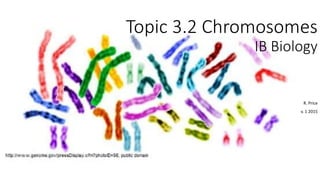DP Bio Topic 3-2 Chromosomes
•Télécharger en tant que PPTX, PDF•
0 j'aime•703 vues
IB DP Biology Topic 3.2 Chromosomes
Signaler
Partager
Signaler
Partager

Recommandé
Recommandé
Contenu connexe
Tendances
Tendances (20)
IB Biology 3.5 Slides: Genetic Modification & Biotechnology

IB Biology 3.5 Slides: Genetic Modification & Biotechnology
Basic concepts of Genes, Chromosomes & DNA: Human Genome Project

Basic concepts of Genes, Chromosomes & DNA: Human Genome Project
General Genetics: The Chromosomal Basics of Heredity

General Genetics: The Chromosomal Basics of Heredity
Similaire à DP Bio Topic 3-2 Chromosomes
Similaire à DP Bio Topic 3-2 Chromosomes (20)
Plus de R. Price
Plus de R. Price (17)
DP Biology Option C6 Nitrogen & Phosphorus Cycles AHL

DP Biology Option C6 Nitrogen & Phosphorus Cycles AHL
DP Biology Topic 4.1 Species, Communities, & Ecosystems

DP Biology Topic 4.1 Species, Communities, & Ecosystems
Dernier
God is a creative God Gen 1:1. All that He created was “good”, could also be translated “beautiful”. God created man in His own image Gen 1:27. Maths helps us discover the beauty that God has created in His world and, in turn, create beautiful designs to serve and enrich the lives of others.
Explore beautiful and ugly buildings. Mathematics helps us create beautiful d...

Explore beautiful and ugly buildings. Mathematics helps us create beautiful d...christianmathematics
Mehran University Newsletter is a Quarterly Publication from Public Relations OfficeMehran University Newsletter Vol-X, Issue-I, 2024

Mehran University Newsletter Vol-X, Issue-I, 2024Mehran University of Engineering & Technology, Jamshoro
Dernier (20)
Salient Features of India constitution especially power and functions

Salient Features of India constitution especially power and functions
Explore beautiful and ugly buildings. Mathematics helps us create beautiful d...

Explore beautiful and ugly buildings. Mathematics helps us create beautiful d...
This PowerPoint helps students to consider the concept of infinity.

This PowerPoint helps students to consider the concept of infinity.
HMCS Max Bernays Pre-Deployment Brief (May 2024).pptx

HMCS Max Bernays Pre-Deployment Brief (May 2024).pptx
On National Teacher Day, meet the 2024-25 Kenan Fellows

On National Teacher Day, meet the 2024-25 Kenan Fellows
UGC NET Paper 1 Mathematical Reasoning & Aptitude.pdf

UGC NET Paper 1 Mathematical Reasoning & Aptitude.pdf
Vishram Singh - Textbook of Anatomy Upper Limb and Thorax.. Volume 1 (1).pdf

Vishram Singh - Textbook of Anatomy Upper Limb and Thorax.. Volume 1 (1).pdf
DP Bio Topic 3-2 Chromosomes
- 1. Topic 3.2 Chromosomes IB Biology R. Price v. 1 2015
- 2. Allott 149
- 3. #1: Prokaryotes have one chromosome consisting of a circular DNA molecule • One chromosome • Circular DNA • Not associated w/ proteins, so “naked” Allott 150
- 5. #2: Some prokaryotes also have plasmids but eukaryotes do not • Extra DNA not in the chromosome • May/may not replicate when chromosome’s replicated • May/may not be passed on during cell replication • Can be transferred to other cells • Can be transferred to other species • Natural method of gene transfer between species • Researchers use to transfer genes artificially Allott 150
- 7. Allott 151
- 8. #3: Eukaryote chromosomes are linear DNA molecules associated with histone proteins Chromosomes in eukaryotes • DNA + histone protein • Histones = globular proteins • Many histones in a chromosome • DNA wind around histone
- 9. #4: In a eukaryote species there are different chromosomes that carry different genes In eukaryotes: • At least two different types of chromosomes • In humans -> 23 types of chromosomes • Genes are found on a specific position on a specific type of chromosome (locus) • Each chromosome carries specific sequence of genes along linear DNA molecule
- 10. #5: Homologous chromosomes carry the same sequence of genes but not necessarily the same alleles of those genes • Two chromosomes carry same sequence of genes = homologous genes • Same sequence, but not identical -> alleles
- 11. Allott 153
- 12. Allott 153, 154
- 13. Allott 154
- 14. #6: Haploid nuclei have one chromosome of each pair • Haploid nuclei have one full set of chromosomes • Has only one chromosome of each type • Some plant life cycles have a haploid phase (ferns) • Gametes (sex cells) are haploid
- 15. #7: Diploid nuclei have pairs of homologous chromosomes • Diploid nuclei have two full sets of chromosomes • Has two chromosomes of each type • Except for sex chromosomes, has two copies of each gene • Advantage: dominant allele may protect from a damaging allele • Advantage: hybrid vigor
- 16. #8: The number of chromosomes is a characteristic feature of members of a species • Fundamental characteristic • Organisms with different number of chromosomes are unlikely to interbreed • # can change, but rare. Can occur during evolution of species • Decrease if chromosome fuse • Increase if chromosomes split
- 17. Allott 155, 156
- 18. Allott 156
- 19. #9: A karyogram shows the chromosomes of an organism in homologous pairs of decreasing length • Cell in metaphase gives clearest view of chromosomes • Chromosomes treated with a stain • Micrograph taken of chromosomes • Computer used to sort chromosomes • Chromosomes sorted by size, position of centromere, and banding after staining • Usually in homologous pairs • Arranged longest to smallest
- 20. #10: Sex is determined by sex chromosomes and autosomes are chromosomes that do not determine sex Humans (rules may change for other species) • X chromosome large, centromere near middle • Y chromosome smaller, centromere near end • One Y chromosome (SRY or TDF) starts development of male features • XX = female • XY = male
- 21. Allott 158
- 22. Allott 158
- 23. Allott 159
- 24. Sources Content Allott, Andrew, and David Mindorff. Biology: Course Companion. 2014 ed. Oxford: Oxford UP, 2014. Print. Oxford IB Diploma Programme. Walpole, Brenda. Biology for the IB Diploma. 2nd ed. Cambridge: Cambridge UP, 2014. Print. Images Unless otherwise noted, images are obtained from Pixabay (www.pixabay.com) and used under the CC0 Public Domain license.
